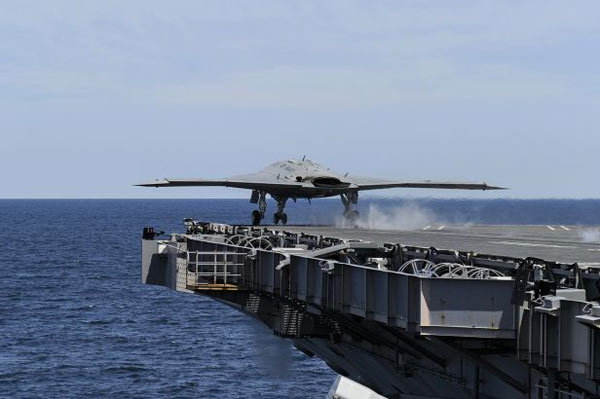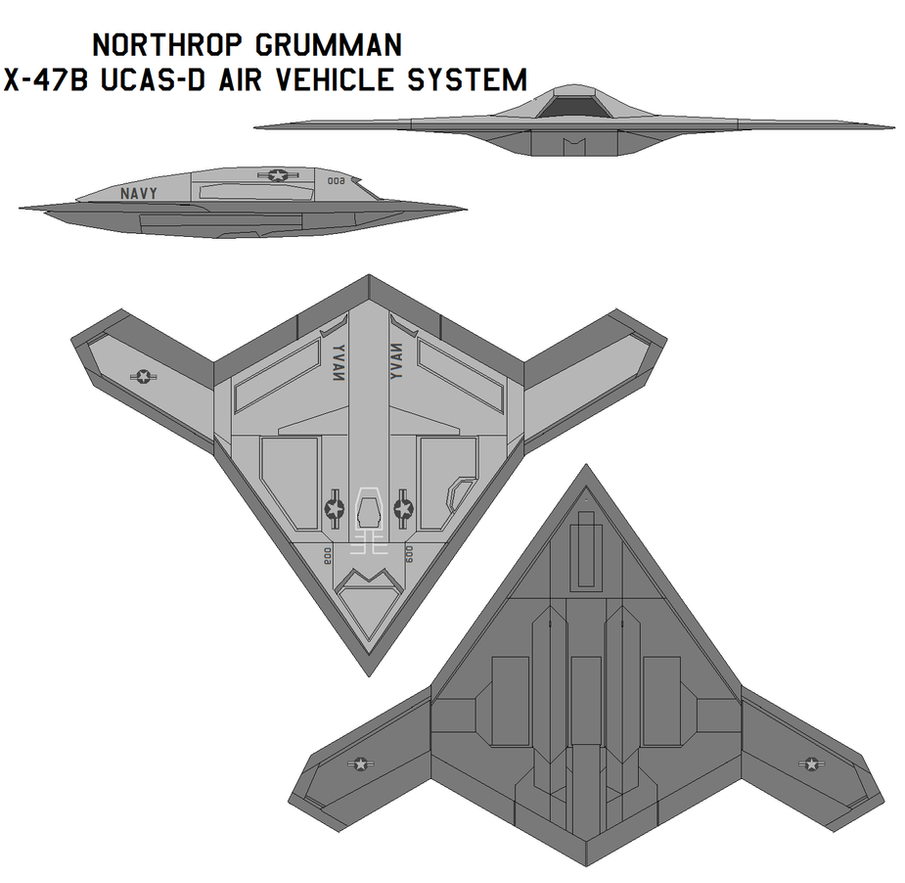
By Roger Connor
Retired in April 2015, the U.S. Navy’s two Northrop Grumman X-47B unmanned air vehicles – known by their call signs as Salty Dog 501 and Salty Dog 502 – represent the most significant progress in Unmanned Combat Aerial Systems (UCAS) to date. Among a number of achievements, the X-47B was the first drone to land on an aircraft carrier and refuel in midair autonomously. With its distinctive sleek tail-less profile, the aircraft has become something of a poster child for the future of military drone technology. But how did the program come about, and why are the Salty Dogs retiring when it seems that the Navy was only just getting started?
The X-47B was the culmination of one of the more enduring Defense Advanced Research Projects Agency (DARPA) efforts in recent history, which began when the U.S. Air Force formalized the Uninhabited Combat Air Vehicle (UCAV) development program with DARPA in August 1997. The project reflected the Air Force’s interest in developing a more survivable platform for heavily contested airspace that could support a variety of missions, including Suppression of Enemy Air Defenses (SEAD) missions. That effort resulted in two Boeing X-45A demonstrators (which first flew in 2002). One of the two X-45s was the first drone to autonomously fire a weapon in testing.
Meanwhile, in 2000, the U.S. Navy had launched a parallel program with DARPA for a UCAV-N (Naval), to develop a carrier-based reconnaissance and attack technology demonstrator. The project called for a drone capable of carrying a 4,000-pound payload, with the ability to loiter for up to 12 hours, and an operational radius of 650 nautical miles. Crucially, it had to be able to take off and land on an aircraft carrier. The Navy’s plan was not to create an aircraft that could be used for operations, but rather one that could simply demonstrate the ability of an unmanned aircraft to function in the busy and complex environment that is a carrier air wing. Under a rapid development program, DARPA and the Navy issued design contracts to Boeing and Northrop Grumman. Boeing responded with a somewhat conservative design designated X-46, based on its X-45 work, and Northrop Grumman submitted the X-47.

Northrop Grumman’s approach was ambitious. It first constructed, on its own dime, a small proof-of-concept demonstrator, nicknamed “Pegasus” (now designated X-47A). The X-47A fulfilled its internal Northrop Grumman objectives with its first (and only) flight in April 2003. It designed a much larger aircraft for the UCAV-N requirement – the X-47B.
In December 2002, DARPA began merging the parallel Air Force and Navy programs under the Joint Unmanned Combat Aerial System (J-UCAS) office. The J-UCAS embraced the larger aircraft for shipboard demonstrations and jettisoned the X-46, allowing Boeing to concentrate on Air Force requirements and Northrop Grumman to concentrate on the Navy.By early 2006, Air Force interest in UCAV had waned since it focused on the immediate problems of integrating a rapidly burgeoning armed UAV contingent in the War on Terror. As a result, the Navy again partnered independently with DARPA to continue X-47B development, now known as the Naval Unmanned Combat Air System (NUCAS). A “D,” for Demonstrator, was later added to the name.
In August 2007, six years since the X-47B began development, Northrop Grumman finally received a contract to build two X-47B air vehicles; in that time, military drones had become much more prominent as a result of the success of the MQ-1 Predator and MQ-9 Reapers in Afghanistan and Iraq. Though development costs were quite significant (reaching nearly $1.5 billion by 2015) the program meshed well with evolving Navy requirements. One such requirement, that the drone be capable of long-range strike missions, reflected the Navy’s new China-centric strategic orientation, including increasing anxiety over advances in Chinese anti-shipping technologies that would require the U.S. Navy to have the ability to launch attacks from a greater range.

The X-47B’s flight tests began in 2011 and lasted for slightly more than four years. During this time, it demonstrated the capacity to carry out a full range of shipboard and non-combat aerial operations such as deck handling, launch and recovery, integration with manned aircraft operations, and in-air refueling from a manned tanker, all important firsts for autonomous UAVs. When Salty Dog 502 autonomously landed on the aircraft carrier USS George H.W. Bush on July 10, 2013, many declared it a historic moment in the development of military drone technology; carrier landings are among the most difficult tasks that a pilot can undertake. While the X-47 successfully demonstrated that it is now possible for a carrier air wing to operate a large drone, the freedom to operate in a contested high-threat and dynamic environment—the Navy’s ultimate goal for a carrier-based combat drone—is much more problematic. Since the X-47B program did not include any weapons or Intelligence, Surveillance, and Reconnaissance (ISR) tests, the program neither validated UCAV survivability in a range of contested threat environments nor did it establish exactly what kinds of missions would be best suited to such technologies. The conclusion of the program at this point suggests that, while certainly impressive, existing core technologies present in the X-47B may have a ways to go before they can support autonomous combat operations.
While certainly impressive, existing core technologies present in the X-47B may have a ways to go before they can support autonomous combat operations.
By the time of the first flight of the X-47B in 2011, the Navy had already begun looking to next steps beyond the Salty Dogs. That same year, the Navy launched the Unmanned Carrier-Launched Airborne Surveillance and Strike (UCLASS) program, which is intended to build on the technology validation of the X-47 program by creating a fully autonomous ISR and strike aircraft for carrier air groups. Since the retirement of the Grumman A-6 Intruder, the Navy and Marine Corps have been without a significant carrier-based deep-strike capability. While the F-18 Super Hornet and F-35 have improved mission capabilities and effectiveness, they have done so at the cost of range and require tanker support that becomes problematic with deep penetration into contested airspace backed with modern air defenses. In such situations, the Navy is almost entirely dependent on the Tomahawk Land Attack Missile, which is not well suited to a changing target environment – for example, Saddam Hussein’s SCUD launchers in the 1991 Gulf War. UCLASS would, ideally, provide the Navy with the ability to strike from far enough away that it would not expose its ships to land-based missile systems, while still having the ability to adapt to a dynamic target and threat environment. The UCLASS concept also offers significant advantages in low observable design with the elimination of a cockpit; that is, it can be stealthy. And of course, without a pilot, the aircraft would eliminate the risk to aircrew.

The UCLASS program quickly garnered considerable interest for supporting a broad range of ISR and combat roles, including as an air-to-air missile weapons aircraft to support manned aircraft engagements. But this same broad range of potential missions that appealed to decision-makers may burden the program with unachievable or conflicting objectives. This is the same problem that has contributed to the ballooning costs of the F-35 Joint Strike Fighter. As with the F-35, meeting all these requirements will not be cheap. A successful UCLASS program will require substantial improvements in current unmanned aircraft technology at a time when the Navy is looking to reduce its risks when acquiring and developing new hardware. To identify and strike mobile and camouflaged targets successfully would require substantive advances in artificial intelligence and sensor technologies. Navy and Congressional support of full-scale UCLASS development as of early 2015 appears significantly restrained by concerns over such developmental and cost risks. The geopolitical environment also suggests possible complications as international advocacy for limiting autonomous weapons systems grows.
As risky as UCLASS may be in the short term, a manned deep-strike fighter with the same capabilities and stealth is even further beyond the scope of the Navy’s existing budgetary authorizations in the foreseeable future. Continuing improvements in anti-shipping weapons systems and rising global tensions with principal military powers will continue to provide momentum for the UCLASS program. While the X-47Bs will now retire, their influence will endure.
Specifications

- Wingspan: 62.1 feet (30.9 wings folded)
- Length: 38.2 feet
- Height: 10.4 feet
- Max Gross Takeoff Weight: 44,000 pounds
- Payload: 4,500 pounds
- Range: 2,100 nm+
- Altitude: 44,000’+
- Powerplant: Pratt & Whitney F100-PW-22
Program Milestones
- X-47A first flight – February 23, 2003.
- X-47B (AV1) first flight – February 4, 2011.
- Deck catapult (land based) demonstration – November 29, 2012.
- Deck handling trials (USS Harry S. Truman CVN 75) – November/December 2012.
- First arrested landing (land based) – May 4, 2013.
- First catapult launch of an autonomous UAV at sea (USS George H.W. Bush CVN 77) – May 14, 2013.
- First fully autonomous recovery aboard a carrier (USS George H.W. Bush CVN 77) for a UAV – July 10, 2013.
- Sustained carrier deck handling and flight operations (USS Theodore Roosevelt CVN-71) – November 2013.
- Integrated manned/unmanned flight operations and night operations (USS Theodore Roosevelt CVN-71) – August 2014.
- First in-flight refueling of an autonomous or remotely piloted aircraft – April 22, 2015.
Roger Connor is a museum specialist in the Aeronautics Department of the National Air and Space Museum. He curates the Vertical Flight, Unmanned Aircraft Systems, and Instruments & Avionics collections.
For updates, news, and commentary, follow us on Twitter.
[includeme file=”tools/sympa/drones_sub.php”]
